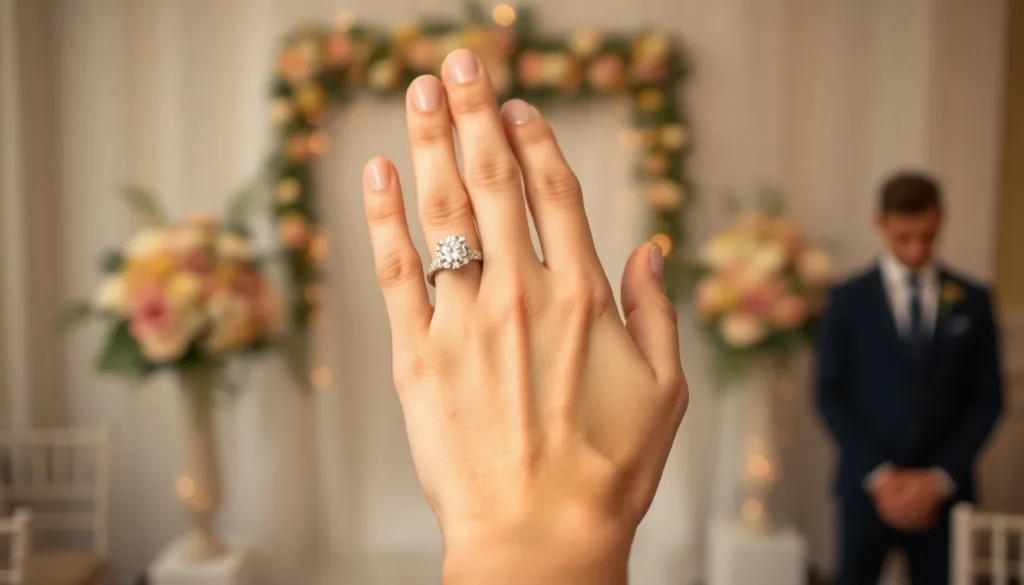Table of Contents
ToggleEver wondered which hand is home to the elusive ring finger? You’re not alone! This finger often gets the spotlight during wedding proposals and engagement parties, yet it seems to confuse even the most seasoned ring enthusiasts.
Understanding the Ring Finger
The ring finger typically refers to the fourth finger on each hand. In many cultures, it holds significant meaning, especially in relation to marriage. Often, the ring finger on the left hand is designated for wedding and engagement rings in Western traditions. In contrast, some countries place the wedding band on the right hand.
Anatomically, the ring finger is located between the middle finger and the pinky finger. This position varies depending on hand orientation. Significantly, finger positioning influences how rings are worn.
Culturally, this finger also embraces traditions beyond marriage. In ancient Rome, people believed a vein connected this finger directly to the heart. Consequently, this belief enhanced its romantic symbolism.
Rings on the ring finger can represent commitment, love, and personal milestones. Examples include promise rings or anniversary bands. Traditionally, individuals may choose to wear these rings to signify special relationships.
Recognizing the ring finger’s role in various cultures enhances its understanding. Diverse customs exist regarding ring placement and significance. Many individuals celebrate engagements and marriages by showcasing rings prominently on these fingers.
Clarifying which hand serves as the ring finger is crucial for accurately identifying symbolic meaning. Engagements typically emphasize the left hand in many parts of the world, while others may vary. Understanding these distinctions enriches the appreciation of this significant finger.
What Hand Is the Ring Finger?

The ring finger, often associated with significant life events, occupies an essential space on both hands. Typically, it is the fourth finger and varies in cultural meaning and usage.
Traditional Practices
Western traditions widely recognize the left hand for wearing wedding and engagement rings. Many couples choose this hand to signify their commitment. In contrast, some cultures honor the right hand for these rings. This practice often stems from historical customs, where different significances were attributed to each hand. Ceremonies throughout history have emphasized the left hand as a symbol of devotion, while the right hand represents faithfulness and loyalty in various contexts.
Cultural Variations
Cultural differences play a crucial role in determining which hand bears the ring finger’s significance. For instance, in countries like Germany and India, the wedding band is customarily worn on the right hand. This choice reflects diverse interpretations of love and partnership across cultures. In some Eastern European nations, individuals wear engagement rings on the right hand, transferring them to the left during the wedding ceremony. These variations underscore the rich tapestry of traditions surrounding love and commitment, highlighting the finger’s varied meanings worldwide.
Significance of the Ring Finger
The ring finger carries deep meanings across cultures and traditions. Many people recognize its importance in wedding ceremonies and engagement celebrations.
Symbolism in Different Cultures
In various cultures, the ring finger symbolizes love and commitment. Western traditions typically associate this finger with engagement or wedding rings on the left hand. Couples in Germany often choose the right hand for their wedding bands, highlighting their unique customs.
Eastern European practices include wearing engagement rings on the right hand, then switching to the left during the wedding ceremony. Such differences illustrate the diverse interpretations of relationships globally. Ancient Romans believed the ring finger contained a vein directly linked to the heart, adding to its romantic symbolism.
Additionally, rings on the ring finger can signify personal milestones. Promise rings and anniversary bands hold significant meaning for those wearing them. Understanding these variations enhances comprehension of the ring finger’s cultural significance in conveying love and commitment.
Popular Uses of the Ring Finger
The ring finger serves various cultural and personal purposes. It’s commonly associated with significant life events.
Engagement and Wedding Rings
Engagement rings typically adorn the ring finger of the left hand in Western cultures. This tradition signifies a promise of marriage. Couples may choose different styles, from solitaire to three-stone settings, reflecting personal tastes. After the wedding, many place the wedding band on the same finger, symbolizing enduring commitment. In some cultures, however, such as in Germany or India, wedding bands are worn on the right hand, showcasing the finger’s significance across traditions. This practice emphasizes the ring finger’s role in celebrating love and partnership.
Other Jewelry and Accessories
The ring finger isn’t limited to wedding bands and engagement rings. Many people wear fashion rings or statement pieces on this finger. Gemstone rings or anniversary bands often find their place here, marking personal milestones. In some cases, promise rings, which symbolize intent and commitment without an official engagement, are also popular choices. Individuals may express their style and personality through the types of rings worn. The ring finger thus serves as a versatile canvas for various forms of jewelry and personal expression.
The ring finger holds a unique place in various cultures and traditions. Its association with love and commitment transcends geographical boundaries, reflecting diverse practices in how individuals express their relationships. Whether it’s the left hand in Western cultures or the right hand in others, the significance of the ring finger remains a powerful symbol of connection.
Beyond weddings and engagements, this finger serves as a canvas for personal expression through jewelry. From promise rings to fashion statements, the ring finger continues to celebrate life’s milestones. Understanding its cultural nuances enriches the appreciation of this simple yet profound gesture of love.







